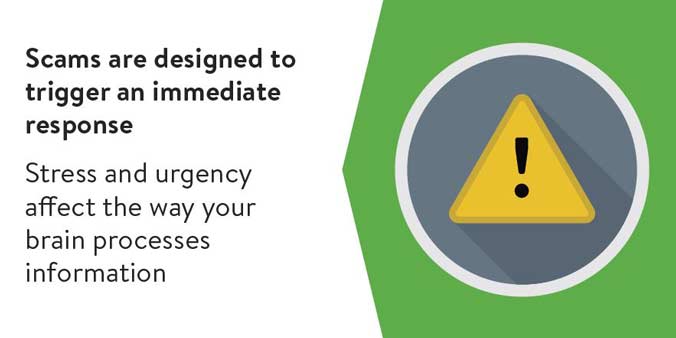
What amygdala hijack is—and what it has to do with fraud
If you use a mobile phone or have an email account, you’ve almost certainly been exposed to an attempt at mass marketing fraud.
You’ve likely been interrupted by an annoying robocall or found a suspicious message in your email inbox that slipped through the spam filter.
Sometimes, the attempted fraud is kind of funny. The wording is so strange or the premise is so ridiculous—“An exiled prince needs my help transferring a million dollars? Really?”—that we’re left wondering how anyone could fall for such a blatant money grab.
Unfortunately, mass marketing scams persist because they work—at least enough to justify the attempts made.
A 2015 Data Breach Investigation report conducted by Verizon found that it takes an average of 82 seconds from the time a phishing campaign is launched for the first victim to fall for the trap.
How do scammers trick the average person into making costly and humiliating mistakes? And why do even the smartest people fall for the simplest scams?
The answer: Amygdala hijack
Behind the robocalls and the cheesy emails, there is some psychology at play.
Scammers are good at crafting situations that create “amygdala hijack,” a term used to describe what happens when the brain perceives an emergency. Fear, urgency or threatening behavior can trigger a reaction in your brain that sidesteps the usual neural pathways.
Amygdala hijack compels you to act before any rational thought can kick in. And this is what many scams are designed to get you to do. In a state of amygdala hijack, you might comply with a scammer’s request before your brain gets a chance to notice any red flags.
This helps explain why smart people fall for (seemingly) obvious scams.
3 tactics that trigger amygdala hijack
To create the degree of urgency that triggers amygdala hijack, scammers rely on the following tactics: Scarcity, authority and credibility.
Scammer tactic #1: Scarcity
This is perhaps the most obvious interpretation of creating a sense of urgency: The scarcity of time.
Targets are presented with a situation that requires immediate action. For example, your account will be deleted unless you enter your password now!
In online sales scams, scarcity of product is often emphasized. Only one product remains at the too-good-to-be-true discounted sale price!
Scarcity can also be applied to success, which plays to people’s desire to benefit themselves financially. In pyramid schemes or investment fraud, a scam might be presented as a limited opportunity.
Scammer tactic #2: Authority
Scammers will often pose as authority figures in an attempt to make demands without being questioned.
Common impersonations include:
- Estate lawyers in email scams offering a large inheritance
- Government representatives in tax scams
- Law enforcement in identity theft
- Businesses like Amazon and FedEx
In emails, scammers pose as authority figures to get you to click on links or provide passwords and information without paying close attention to the message or its sender.
Some scammers abuse their fraudulent powers of authority further by using threatening or aggressive behavior to bully their targets into compliance.
Scammer tactic #3: Credibility
We often look to family, friends and even other consumers when making decisions. And scammers use this to their advantage. They impersonate others to make a scam seem more credible.
A common example is fake product reviews on online shopping sites. The fraudulent seller will fabricate identities and post glowing reviews to influence a purchase and bury any accurate (and negative) reviews.
In other scams, existing connections help make a scam seem legitimate.
Scammers might use social media posts to figure out when you’re out of town or on vacation. Then, posing as you, they contact friends, relatives or coworkers and request financial help with an emergency. Because you’re on vacation, the request seems more legitimate, making it easier for others to overlook the scam.
How to avoid amygdala hijack
Even though scams come in all shapes and sizes and via different communication methods, there are some underlying similarities.
Keeping an eye out for tactics like scarcity, authority and credibility will help you flag potential fraud.
Even when presented with a stressful situation, pause and think before acting. Although the circumstance might seem time-sensitive, think about whether the context of the situation makes sense.
Verify the legitimacy of the communication. Don’t use the contact information that the potential scammer provided—call them back through the main number listed on an official website.
If someone is claiming to be your friend, but the circumstance is suspicious, verify their identity through another form of communication, like a phone call or text message.
Don’t worry about being polite. Verifying the identity of the person or company you’re talking to is a reasonable thing to do.
It also helps to take preventive measures by being careful with your personal information and using privacy settings on social media accounts.
Whether it’s online, over the phone or in person, scammers constantly come up with new ways to influence targets to act in ways they might not otherwise.
By staying calm in high-stress situations and giving ourselves a little extra time to think, we’re better able to spot recurring scammers’ favorite tactics, avoid a state of amygdala hijack and save ourselves from making costly mistakes.





